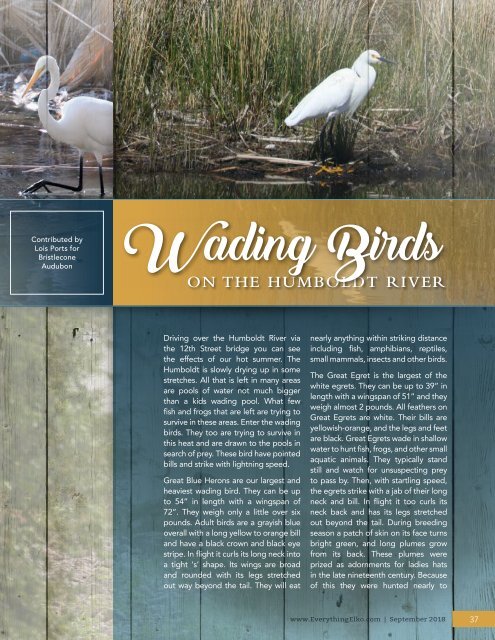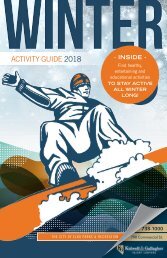eesept18
Create successful ePaper yourself
Turn your PDF publications into a flip-book with our unique Google optimized e-Paper software.
Contributed by<br />
Lois Ports for<br />
Bristlecone<br />
Audubon<br />
ON THE HUMBOLDT RIVER<br />
Driving over the Humboldt River via<br />
the 12th Street bridge you can see<br />
the effects of our hot summer. The<br />
Humboldt is slowly drying up in some<br />
stretches. All that is left in many areas<br />
are pools of water not much bigger<br />
than a kids wading pool. What few<br />
fish and frogs that are left are trying to<br />
survive in these areas. Enter the wading<br />
birds. They too are trying to survive in<br />
this heat and are drawn to the pools in<br />
search of prey. These bird have pointed<br />
bills and strike with lightning speed.<br />
Great Blue Herons are our largest and<br />
heaviest wading bird. They can be up<br />
to 54” in length with a wingspan of<br />
72”. They weigh only a little over six<br />
pounds. Adult birds are a grayish blue<br />
overall with a long yellow to orange bill<br />
and have a black crown and black eye<br />
stripe. In flight it curls its long neck into<br />
a tight ‘s’ shape. Its wings are broad<br />
and rounded with its legs stretched<br />
out way beyond the tail. They will eat<br />
nearly anything within striking distance<br />
including fish, amphibians, reptiles,<br />
small mammals, insects and other birds.<br />
The Great Egret is the largest of the<br />
white egrets. They can be up to 39” in<br />
length with a wingspan of 51” and they<br />
weigh almost 2 pounds. All feathers on<br />
Great Egrets are white. Their bills are<br />
yellowish-orange, and the legs and feet<br />
are black. Great Egrets wade in shallow<br />
water to hunt fish, frogs, and other small<br />
aquatic animals. They typically stand<br />
still and watch for unsuspecting prey<br />
to pass by. Then, with startling speed,<br />
the egrets strike with a jab of their long<br />
neck and bill. In flight it too curls its<br />
neck back and has its legs stretched<br />
out beyond the tail. During breeding<br />
season a patch of skin on its face turns<br />
bright green, and long plumes grow<br />
from its back. These plumes were<br />
prized as adornments for ladies hats<br />
in the late nineteenth century. Because<br />
of this they were hunted nearly to<br />
www.EverythingElko.com | September 2018<br />
37
















